Index

Review: GTX 480 Beast is the fastest Fermi around
Today we’ll finish up our talk on GTX 480 Beast, a card that’s anything but ordinary, which again isn’t a surprise considering that Point of View and TGT teams are behind it. GTX 480 Beast is special for its higher operating clocks, which means better performance as well as higher pricing. GTX 480 Beast card is already famous for its performance and we’re currently looking at the fastest factory-clocked GTX 480 card; GPU runs at 810MHz whereas GDDR5 memory runs at 950MHz (3800MHz effectively). Unfortunately, the price of €661 will definitely make some users reconsider a purchase. Note however that the card comes significantly overclocked, has a water block that will do a world of good for cooling and noise levels and to top it all off, it’s covered by warranty.
Point of View / TGT recently started their overclocking endeavors, and already the Beast series is proudly sitting as the fastest of all GTX 480 cards. Beast moniker is found only on the fastest, crème of the crop cards, whereas the slower ones come with Ultra Charged and Charged monikers. Note that only the GTX 480 Beast comes with a water block – the rest use reference cooling.
GTX 480 card was announced more than six months ago, so Point of View / TGT perhaps comes a bit late. On the other hand, since TGT team is only warming up, we’re anxious to see their future products arriving in time, which was the case with GTX 460 Beast/Ultra Charged/Charged cards.
Point of View / TGT GTX 480 Beast uses Innovatek’s water cooling block – Cool-Matic GTX 480. You can purchase this block separately for €199, and it has been specially designed for cooling GTX 480 cards. Furthermore, Cool-Matic will not only take care of cooling the GPU, but the memory and power circuitry as well. We’ve already heard rumors about Cool-Matic GTX 480, but it appears like Innovatek hesitated because of low demand for GTX 480 water blocks. Fortunately, it seems like orders from Point of View / TGT have remedied that and played a significant role in launching the product.
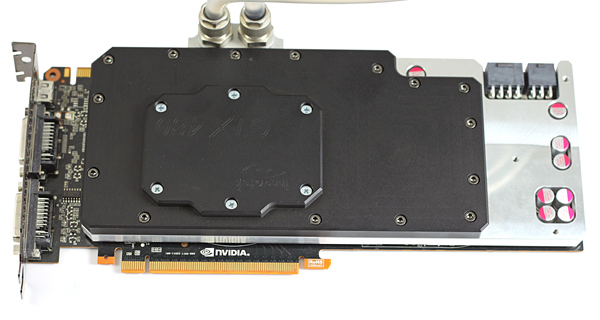
Cool-Matic GTX 480 cooler has 137 parts (including the screws) and is in direct contact with the PCB at no less than 59 points.
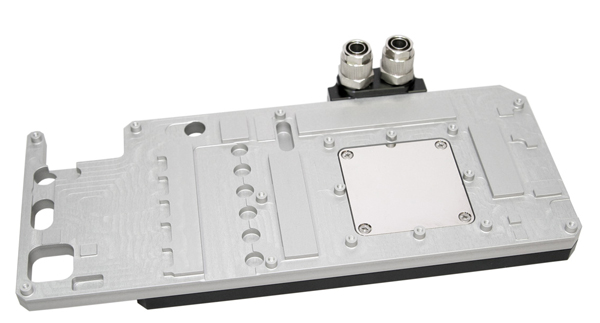
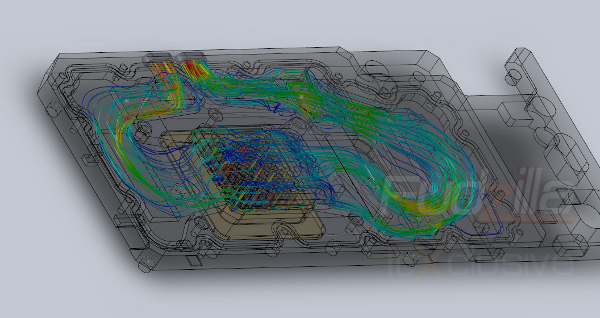
Innovatek uses the new Injektor PRO technology making the water block internals more complex, but in turn providing improved cooling performance. On its own, Cool-Matic GTX 480 costs about €199 although when we first wrote about GTX 480 a few weeks ago, it was listed on Innovatek’s page with a €189 price tag.
GTX 480 Beast is a dual slot card, and the following picture clearly shows that the water block is more than one slot wide.
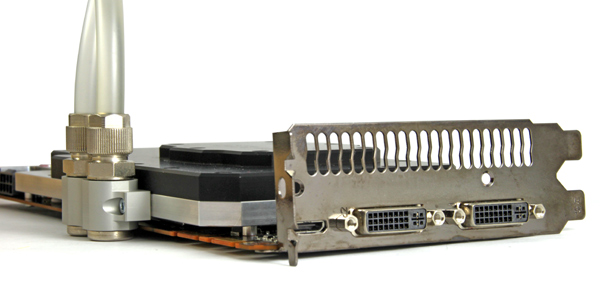
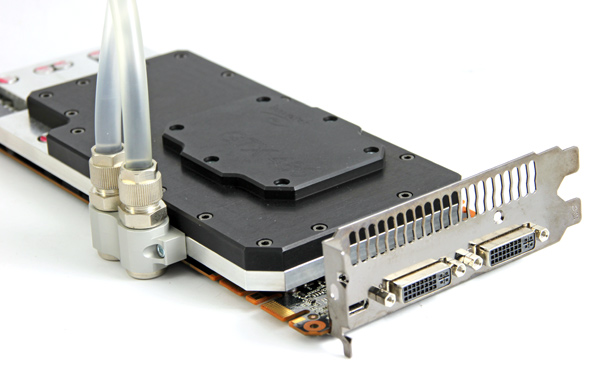
Just like the reference card, the GTX 480 Beast is powered via one 6-pin and one 8-pin connector.
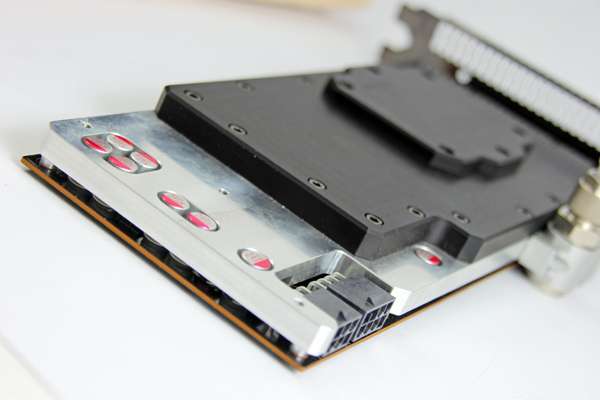
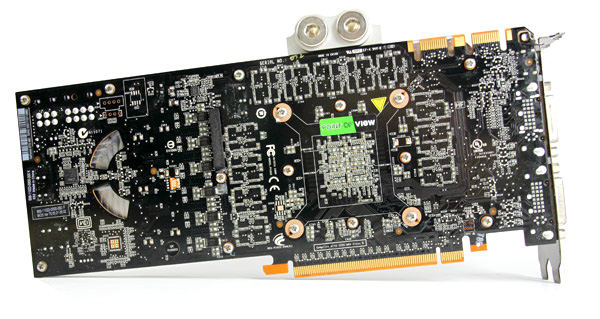
Testbed:
Motherboard: EVGA 4xSLI
CPU: Core i7 965 XE (Intel EIST and Vdrop enabled)
Memory: 6GB Corsair Dominator 12800 7-7-7-24
Harddisk: OCZ Vertex 2 100 GB
Power Supply: CoolerMaster Silent Pro Gold 800W
Case: CoolerMaster HAF X
Fan Controler: Kaze Master Pro 5.25"
Operating System: Win7 64-bit
260.63_desktop_win7_winvista_64bit_english
10.9 CCC
3DMark Vantage
3DMark Vantage rates the GTX 480 Beast as much as 31% faster than the reference GTX 480. GTX 480 Beast is the fastest single-GPU card and while it's capable of beating the HD 5870 by up to 37%, dual-GPU HD 5970 clearly takes the cake in 3DMark Vantage.

Aliens vs Predator
In this game, GTX 480 Beast outruns the reference GTX 480 by up to 12%. The difference between the GTX 480 Beast and dual-GPU HD 5970 is lower in antialiasing tests and even lower after we pushed the resolution; at 2560x1600 the difference is 12% whereas 1920x1080 results in 16% difference.
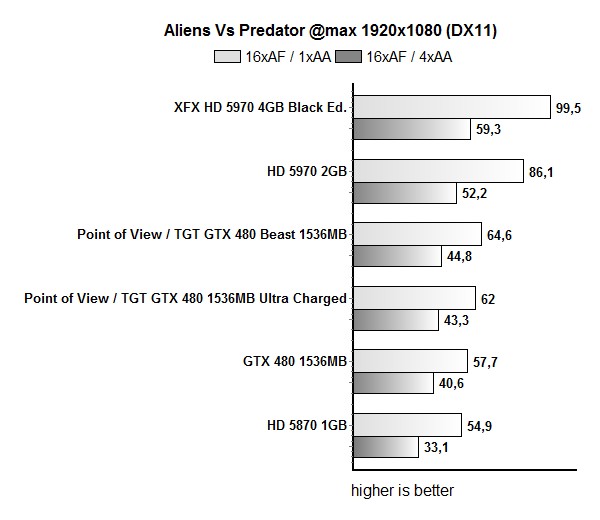
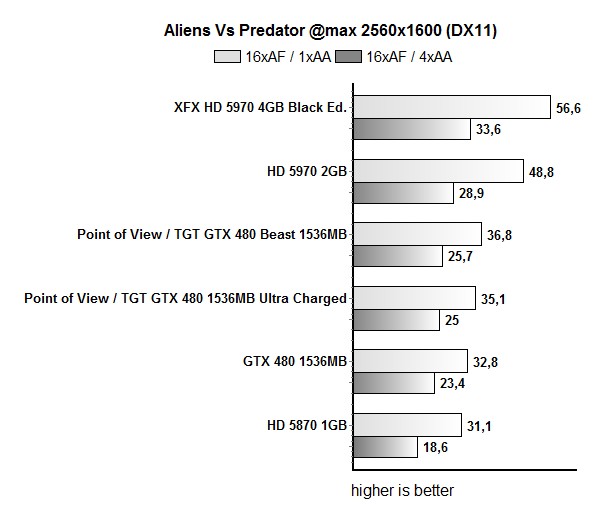
Dirt 2
Dirt 2 at 1920x1080 sees the GTX 480 Beast outrun the dual-GPU HD 5970, but the aforementioned card retakes the lead at 2560x1600. Reference GTX 480 is slower than its beastly cousin by 12%.
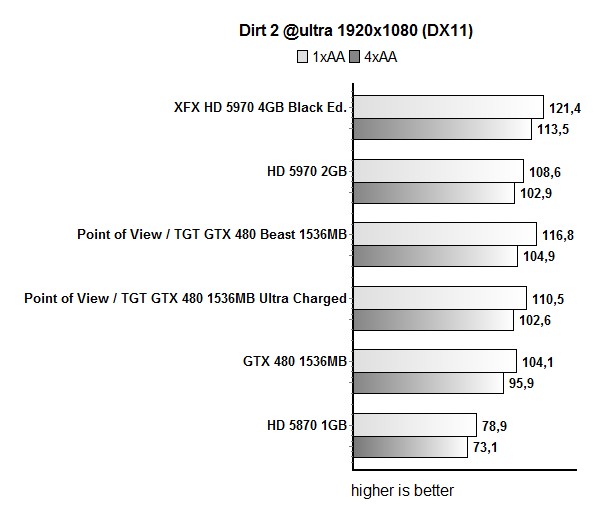
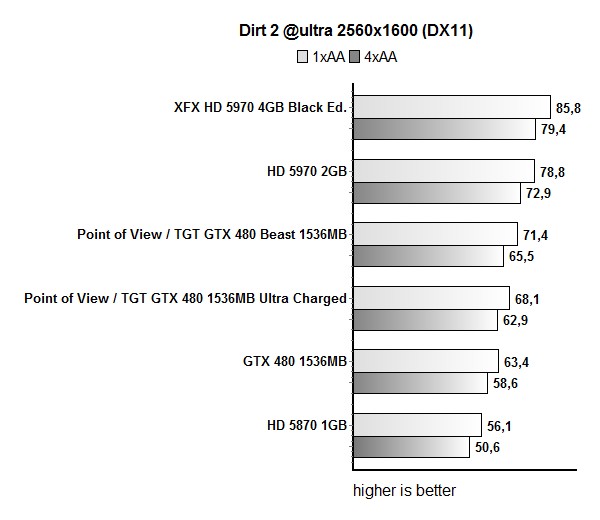
Metro 2033
This game sees the highest difference between the reference and Beast GTX 480 cards – 16,5%. At 2560x1600, Radeon HD 5870 runs slower than GTX 480 by 58%, whereas the dual-GPU HD 5970 runs on par with GTX 480 Beast.
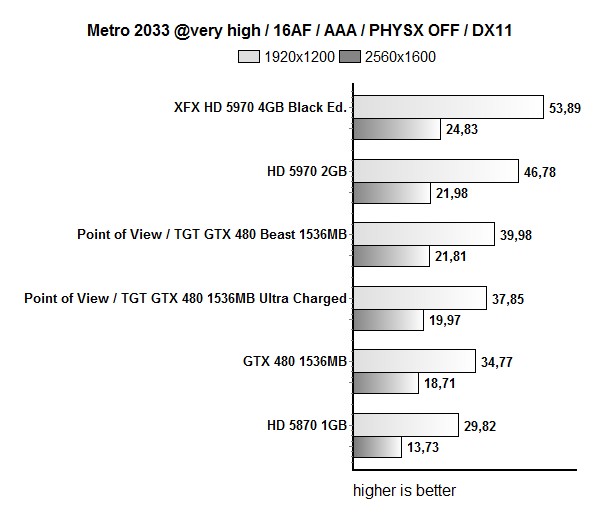
Tesselation test - Unigine Heaven v2.1
The distinguishing feature of this benchmark is hardware tessellation, a scalable technology aimed for automatic subdivision of polygons into smaller and finer pieces, so that games gain drastically detailed and more elaborated look almost free of charge in terms of performance. Tessellation feature REQUIRES both video card with DirectX 11 support and MS Windows Vista/7!
There are three tessellation modes available in this version of the benchmark:
Moderate Mode : This mode is targeted to provide reasonable performance on a wide range of DX11 hardware.
Normal Mode : Default mode available in the benchmark shows optimal quality-to-performance ratio. That's the way to achieve prominent visual difference with hardware tessellation technology.
Extreme Mode : It is designed to meet the perspectives of the next series of DX11-capable hardware pushing up the tessellation level to the extreme in the next 1-2 years.
Source, unigine.com
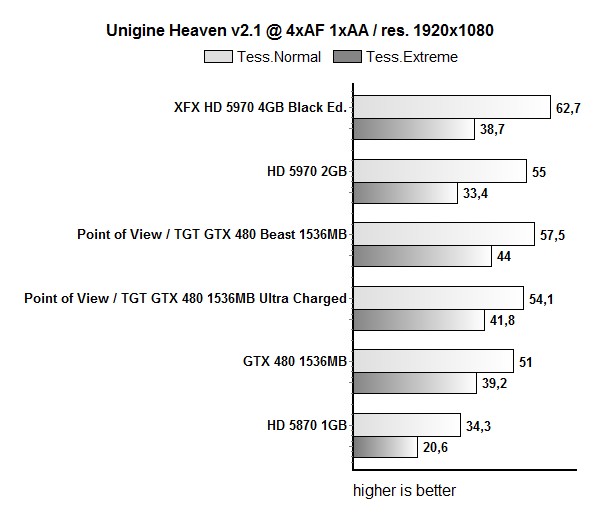
Tesselation test - TessMark
TessMark is an OpenGL 4 benchmark. That means you can play with GPU tessellation under Windows XP, Vista and Seven. Of course, you need a GeForce GTX 400 series or a Radeon HD 5000 Series. No GPU tessellation with previous generation of graphics cards!
Like Unigine Heaven, TessMark allows to select the level tessellation. The small difference is that TessMark proposes four differents levels (moderate, normal, extreme and insane), source geeks3d.com / oZone3D.net
GTX 480 Beast outruns the reference GTX 480 in OpenGL tessellation test by 14%.
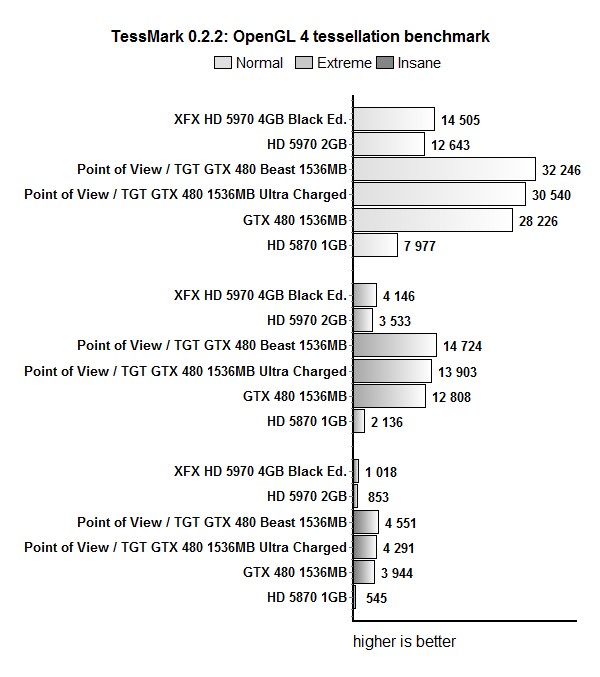
FurMark
FurMark is a very intensive OpenGL benchmark for the graphics card. The benchmark offers several options allowing the user to tweak the rendering: fullscreen / windowed mode, MSAA selection, window size, duration.
Increased graphics workload / power draw of FurMark 1.8.0 for all new graphics monsters such as HD 5870, HD 5970 or new GTX 480, leads to less FPS and lower scores compared to FurMark 1.7.0, source oZone3D.net / geeks3D.com
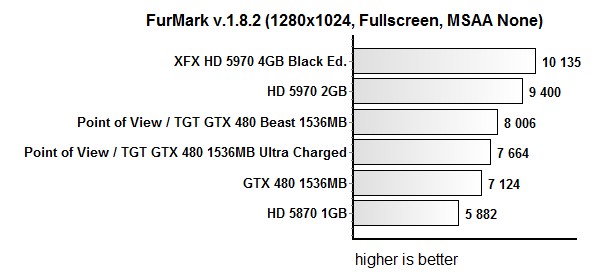
Overclocking, Consumption, Thermals
Of course, many will want to know about GPU temperatures, as this hasn’t quite been the selling point of GTX 480 cards. Our today’s card however, comes with water cooling, which promises to change that. The water cooling system included a PPS Plus 12V Pump (Innovatek / Eheim) and a radiator with three silent Ebm-Papst 4412 F/2GL fans.
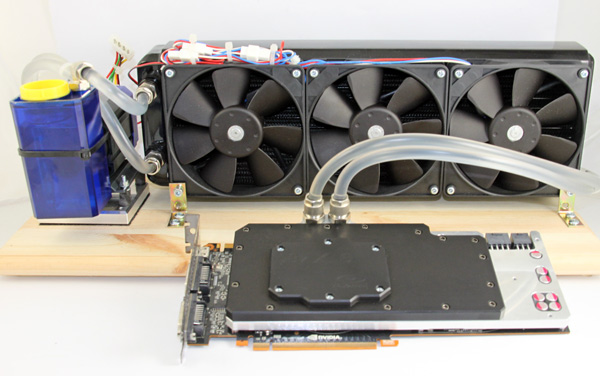
Power consumption and performance-per-watt ratio on GTX 480 cards have received more than enough criticism and the following table shows exactly why. It’s perfectly normal and expected for an overclocked GTX 480 Beast to draw more power than the reference GTX 480, although we must admit we’re still hoping that Nvidia’s next generation high end cards will draw less power.
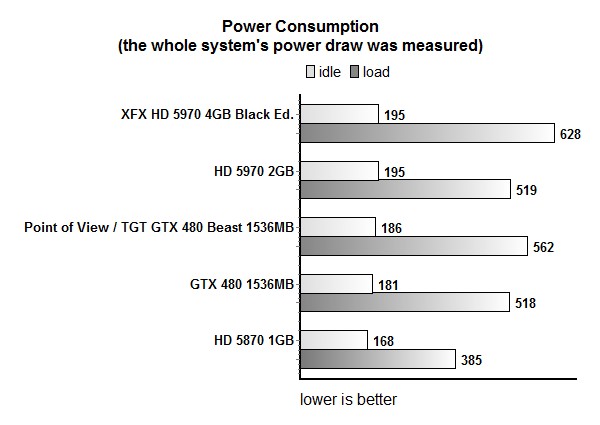
We used default voltages during our testing, which on the GTX 480 Beast’s GPU were at 1100mV.
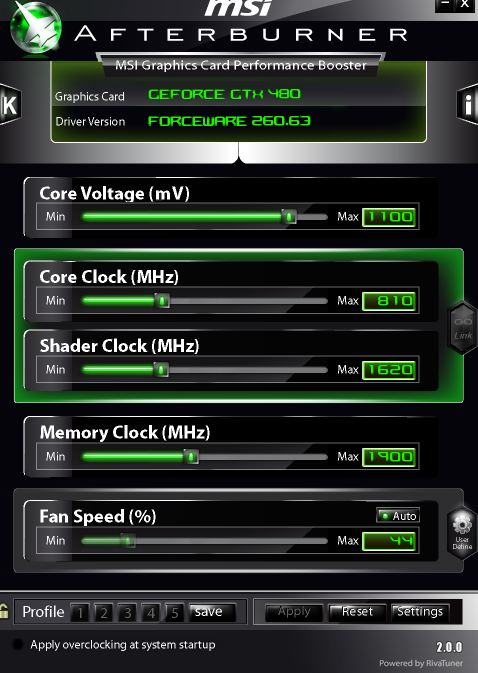
The following photo shows GPU temperatures during FurMark testing. Note that this is the worst case scenario solely for testing purposes, and you’re not likely to replicate this in everyday work.
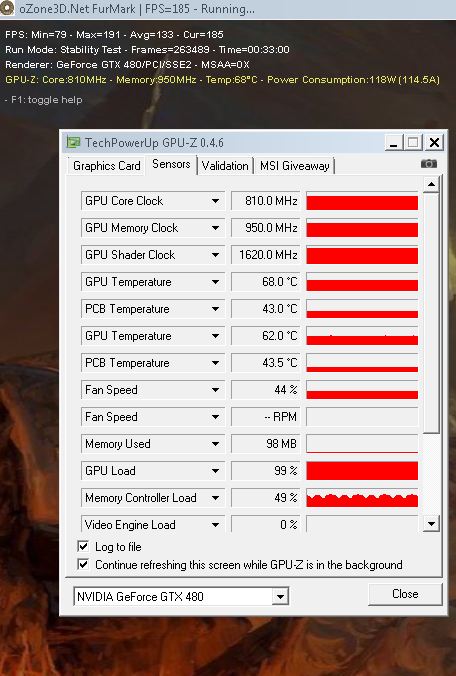
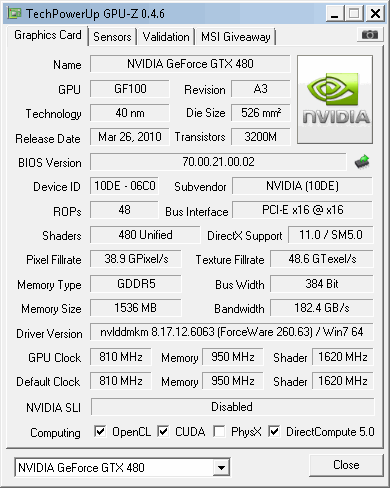
The GTX 480 Beast ran stable at 880MHz GPU and 4300MHz memory, and all that without meddling with voltages.
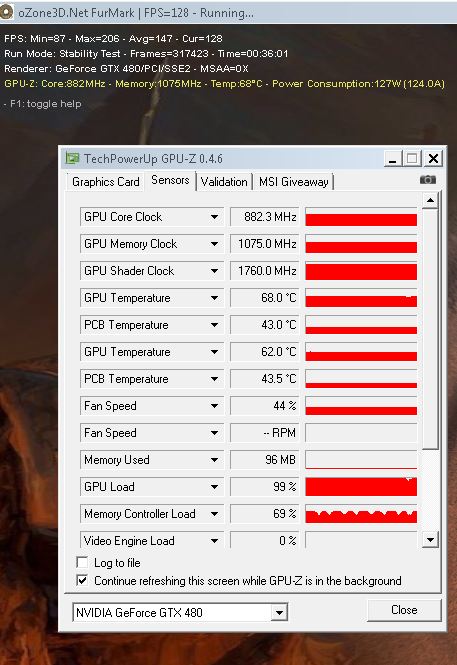
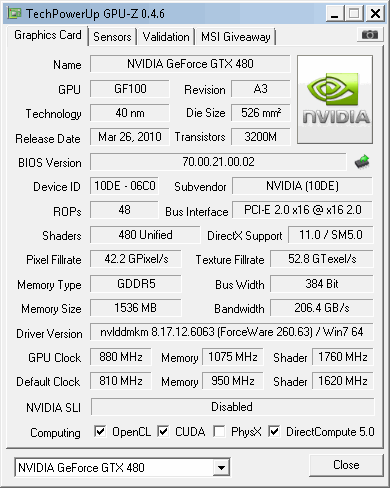
Pushing the voltage to 1125mV did just enough to make the GPU run stable at 895MHz, with GPU temperatures staying at 68°C. 1138mV didn’t change the scenario and not even 1150mV helped the GPU run stable beyond 895MHz.
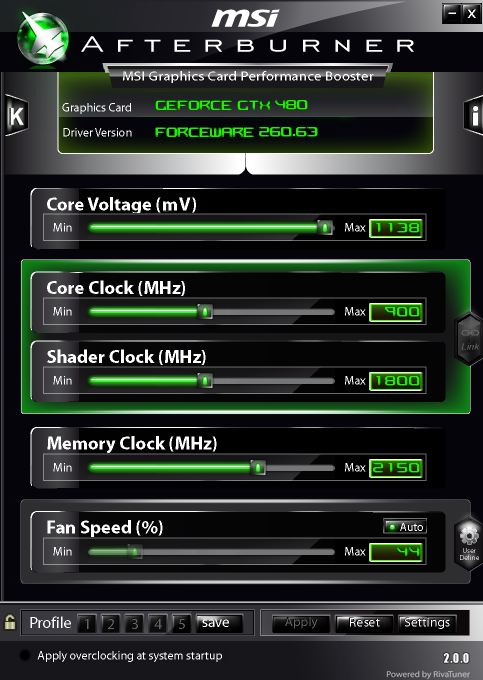
Conclusion
A few days ago, Point of View / TGT launched the GTX 480 Beast, a card that comes factory overclocked to 810MHz GPU and 950MHz memory (3800MHz effectively). The overclock resulted in up to 14% better performance compared to the reference card, making our today’s test sample the fastest GTX 480 around. The benefits of water cooling and improved performance does not come without a cost though, and and you’ll have to splash out about €661, here. Note that such high pricing is for the most part Innovatek’s “fault”, as their Cool-Matic GTX 480 block costs €199 when purchased separately.
The GTX 480 is already known for its high consumption and pretty high noise levels, and while GTX 480 Beast will solve the noise and thermals, the consumption is naturally even higher. Whether this is the perfect card for you is naturally not ours to say. What we can tell you, though, is that the GTX 480 is currently the fastest single-GPU card around, which means that it will take anything you throw at it in stride, regardless of whether it’s demanding games or PhysX and CUDA apps.



